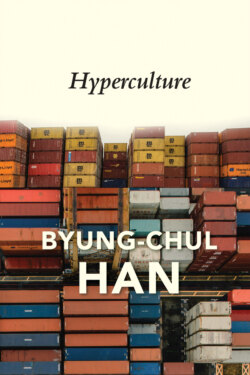Читать книгу Hyperculture - Byung-Chul Han - Страница 9
ОглавлениеThe Eros of Interconnectedness
In a posthumously published fragment, ‘Die Zeit bedenken’ [Thinking of Time], Vilém Flusser reflects on the temporality that characterizes the information society.1 He distinguishes between three forms of time: the time of the image, the time of the book and the time of the bit – in geometrical terms, plane-like time, linear time and point-like time. The time of the image belongs to mythical time. Mythical time is a perspicuous order in which every thing has its fixed place. If something moves away from its place, it is put back. The time of the book belongs to historical time. Historical time is the linearity of history. It is a stream flowing from the past into the future. All events point towards either progress or decay. Today’s time, by contrast, possesses neither a mythical nor a historical horizon. It lacks any comprehensive horizon of meaning. It is de-theologized, or de-teleologicized, into an ‘atom-like’ ‘universe of bits’, a ‘mosaic universe’ in which possibilities ‘buzz’ like points, or ‘sprinkle’ like ‘grains’, as ‘discrete sensations’:
These possibilities advance towards me: they are the future. Wherever I happen to look, there is the future…. Put differently: the void that I am is not passive, but like a vortex it sucks in all the possibilities that surround it.
In this ‘universe of points’, there are no ‘images’, no ‘books’ to limit the possibilities. Rather, Dasein is surrounded by freely hovering possibilities. In this way, the ‘universe of points’ promises greater freedom. After all, the future is ‘everywhere’ that I ‘turn to’.
The possibilities increase, Flusser continues, if I include others in my own time, that is, if I ‘acknowledge’ and ‘love’: ‘I am not alone in the world; there are also others in it…. By putting my own future at the disposal of the other I have the other’s future at my disposal.’ Perhaps Flusser would also understand interconnectedness as a practice of love and acknowledgement, for interconnectedness expands the future by creating a hyperspace of possibilities. The fundamental traits of the Dasein that inhabits this hypercultural universe would be not ‘fear’ and ‘isolation’ but Eros and interconnectedness.
The increasing interconnectedness of the world, whether it is driven by ‘Eros’ or by some altogether different human inclination, creates an abundance, even an overabundance, of relations and possibilities. The saturated space of possibilities, the hyperspace of possible options, exceeds the ‘facticity’ which would otherwise limit the ‘projection’, the freedom of choice, to speak with Heidegger, to ‘the possibility it has inherited’: ‘The resoluteness in which Dasein comes back to itself, discloses current factical possibilities of authentic existing, and discloses them in terms of the heritage which that resoluteness, as thrown, takes over.’2 ‘Thrownness’ is surely not one of the traits of today’s human existence. Contemporary existence corresponds rather to ‘being projected’. The excess of possibilities enables a projection of Dasein beyond the horizon of ‘inheritance’ and ‘tradition’. Excess therefore has a de-facticizing effect, which leads to an increase in freedom. ‘Dasein’ is de-facticized into a homo liber. Microsoft’s famous slogan ‘Where do you want to go today?’ encodes the de-facticization of Dasein, which dis-inherits Dasein and makes it into a hypercultural tourist. Today’s culture is characterized by de-facticization. De-facticization releases Dasein from its ‘thrownness’ and thereby increases its freedom.
‘Hypercultural tourist’ is another name for de-facticized Dasein. Being a tourist does not necessarily mean being physically on the move. Already at home, the hypercultural tourist is either somewhere else or on the go. It is not that we leave our houses as tourists in order to return later as natives. The hypercultural tourist is already a tourist when at home. Still here, he is already there. He never arrives at a final destination.
The Heidegger of Being and Time was already convinced that all interconnecting media level out differences and produce a ‘dictatorship of the “they”’. As he put it in Being and Time:
In utilizing public means of transport and in making use of information services such as the newspaper, every Other is like the next. This Being-with-one-another dissolves one’s own Dasein completely into the kind of Being of ‘the Others’, in such a way, indeed, that the Others, as distinguishable and explicit, vanish more and more.3
The idea that media may bring about a multiplication of forms of life and possibilities is alien to Heidegger. Because he feels uneasy about diversity, he would also not want to oppose the monotony of the ‘they’ with a plurality of projections of Dasein. Faced with a colourful patchwork society, he would invoke the ‘we’ of a community of fate. Heidegger’s philosophy of ‘dwelling’ and of the ‘site’ is ultimately an attempt to re-facticize Dasein.
Notes
1 1. Vilém Flusser, ‘Die Zeit bedenken’, in Lab: Jahrbuch für Künste und Apparate (2001/2), pp. 126–30.
2 2. Martin Heidegger, Being and Time, trans. John Macquarrie and Edward Robertson, Oxford: Basil Blackwell, 1962, pp. 437 and 435.
3 3. Ibid., p. 164.
